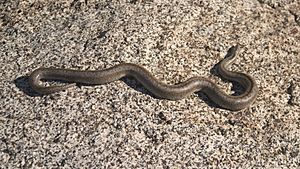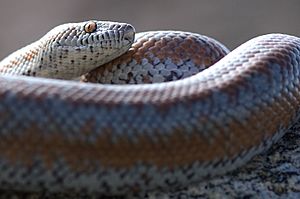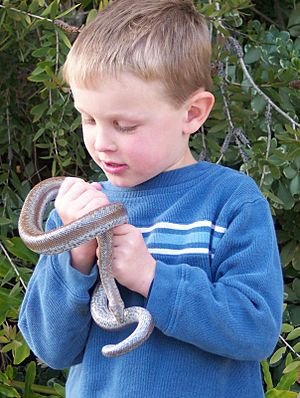Rosy boa facts for kids
Quick facts for kids Rosy boa |
|
|---|---|
 |
|
| Conservation status | |
| Scientific classification | |
| Kingdom: | |
| Class: | |
| Order: | |
| Family: | |
| Genus: |
Lichanura
|
| Binomial name | |
| Lichanura trivirgata |
|
The rosy boa (Lichanura trivirgata) is a type of snake that belongs to the Boidae family. It is one of only two boa species that naturally live in the United States. The other one is called the rubber boa. Rosy boas are found in the southwestern parts of America, as well as in Baja California and Sonora, Mexico.
Contents
What Does a Rosy Boa Look Like?
Rosy boas are usually small snakes. Most of them grow to be about 17 to 34 inches (43 to 86 cm) long, including their tail. Some rosy boas living near the California coast can grow a bit longer, reaching 36 to 44 inches (91 to 112 cm). A grown-up rosy boa's body is about as wide as a golf ball.
Their colors can be very different depending on where they live. The name "rosy boa" comes from the pink or salmon color often seen on the belly of snakes from coastal southern California and Baja Mexico. However, many rosy boas don't have this pink belly. Instead, they might have dark or orange spots on a lighter background.
Almost all rosy boas have at least a little bit of three stripes running along their body. One stripe goes down the middle of their back, and two others are on their lower sides. These stripes can look very different. Some are straight and stand out a lot, while others are broken up and blend in more. The stripes can be orange, maroon, rust, brown, or black. The spaces between the stripes can be light gray, dark gray, yellow, or tan.
Where Do Rosy Boas Live?
Rosy boas live in the dry, desert-like areas of Aridoamerica. You can find them in the southwestern United States, specifically in California and Arizona. They also live in northwestern Mexico, in the states of Baja California and Sonora.
In California, rosy boas are found throughout the Colorado Desert and Mojave Desert. They also live in coastal areas like Los Angeles, Orange, Riverside, and San Diego Counties. In Arizona, they live in the Mojave Desert and the western parts of the Sonoran Desert. They are not found in the eastern or northern parts of Arizona. In Sonora, Mexico, rosy boas live from the U.S. border south through the Sonoran Desert. In Baja California, they are found almost everywhere, except in very dry or rocky desert areas.
How Do Rosy Boas Behave?
Rosy boas spend most of their time hidden. They hide under rocks and in cracks to stay safe from bad weather and animals that might hunt them. They often live near granite rocks, but sometimes you can find them near other types of rocks. In places with few rocks, rosy boas use burrows made by rodents to hide.
Rosy boas are active when the weather is right. They usually rest during the cold winter months. They become active in the spring, summer, and fall. Like all snakes, they need warmth from outside to help their bodies work properly, like digesting food and having babies. When it's too cold in winter, rosy boas go into a sleepy state called brumation.
Spring is when rosy boas are most active because it's their breeding season. This is when you are most likely to see them as they leave their hiding spots to find mates. They also move around to find food or new places to live.
Rosy boas can be active at any time of day. However, when the weather is hot, they mostly come out at night. In the spring, they are often out in the afternoon and early evening. As spring turns into summer, they become more active from dusk until late at night. Since most rosy boas live in very dry places, their activity often depends on how much moisture is around. During dry times, they stay deep underground to stay hydrated. After it rains, you might see many more rosy boas on the surface.
What Do Rosy Boas Eat?
Rosy boas mainly hunt small mammals. Sometimes, they also eat other things like lizards or birds. A big part of their diet includes Pack rats, baby rabbits, deer mice, and kangaroo rats.
Rosy boas are some of the slowest-moving snakes in the world. They cannot chase their prey. Instead, they either wait hidden to ambush their food or slowly stalk it. When a meal is close enough, usually just a few inches away, a rosy boa strikes very quickly and accurately. They grab their prey with tiny, sharp teeth. Then, they squeeze the prey until it cannot breathe, which is called constriction.
How Do Rosy Boas Defend Themselves?
Rosy boas are usually very calm when people find them. If they feel bothered, they often roll into a tight ball with their head tucked in the middle. They usually do not bite to defend themselves. Instead, they might release a bad-smelling musk from the base of their tail if they feel threatened. If a rosy boa bites a human, it's usually because it thought a captive animal was food. Rosy boas are not venomous, meaning they don't have poisonous bites. Because they are so calm, easy to care for, and have pretty colors, rosy boas are popular pets for people who like snakes.
Life Cycle and Reproduction
Rosy boas give birth to live young, meaning the babies hatch inside the mother and are born alive. A mother rosy boa usually has about six babies in one group. Newborn rosy boas are about 12 inches (30 cm) long.
Rosy Boas as Pets
Rosy boas make great pet snakes because they are generally calm and don't get very big. They are easy to care for and don't need a huge enclosure. Many rosy boas are bred in captivity, and they readily eat mice that you can buy from stores. You can find them in many different colors, including albino versions, and various types depending on where their family came from. Even though they are good pets, other snakes like corn snakes, milk snakes, and ball pythons are more popular in the pet market.
See also
 In Spanish: Lichanura para niños
In Spanish: Lichanura para niños





